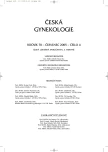Antibiotics prophylaxis in laparoscopy
Authors:
I. Kocák; C. Üstün; B. Emre; A. Uzel
Authors‘ workplace:
Department of Obstetrics and Gynecology, University of Ondokuz Mayis, Medical School Samsun, Turkey
Published in:
Ceska Gynekol 2005; 70(4): 269-272
Category:
Original Article
Overview
Objective:
This study was to determine which prophylactic antibiotic regimen is most effective in reducing the incidence of infectious morbidity in women undergoing laparoscopy.
Design:
Randomized, nonblinded comparative study of a single preoperative dose of first generation cephalosporins vs. the control group which did not receive the antibiotic.
Methods:
The operations were performed using standard technique. Women (n = 450) with indication for laparoscopy were randomly allocated to two groups. Group 1 (n = 200) received the single dose in first generation cephalosporins and group 2 (n = 250) did not receive it. Both groups were followed up during 7 days for detection of signs of wound infection, idiopathic fever, peritonitis and urinary tract infection, and respiratory tract. Prevalence of postoperative infection, mean hospital stay.
Results:
Women completing the study (n = 450) were distributed into group 1 (n = 200) and group 2 (n = 250). No significant difference was found either in the prevalence of postoperative infection or in the mean hospital stay. No death occurred. Each patient was assessed daily until discharge to evidence wound infection, idiopathic fever, peritonitis and urinary tract infection, and respiratory tract. Hospital stay did not differ significantly between groups (p>0.005).
Conclusion:
In our setting, the administration of a single dose of 2 g of first generation cephalosporins before laparoscopy for prevention of infection is clinically equivalent to control group. Single dose of 2 g of first generation cephalosporins appears to offer no added benefit over control group.
Key words:
prophylactic, antibiotics, laparoscopy
Labels
Paediatric gynaecology Gynaecology and obstetrics Reproduction medicineArticle was published in
Czech Gynaecology

2005 Issue 4
Most read in this issue
- Prenatal Parvovirus B19 Infection in Fetus
- The Detection of p16 Protein in Uterine Cervix Lesions
- Changes in Vesicalization of Urethra and Bladder after TVT Operation
- Antibiotics prophylaxis in laparoscopy
